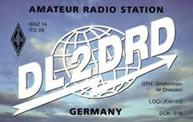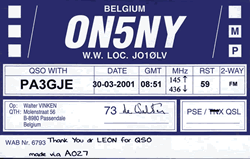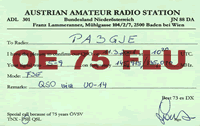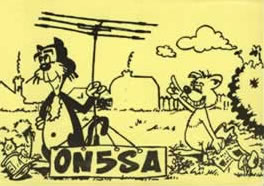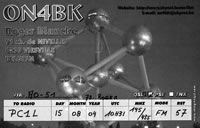|
Satellite
QSO ( Some very short Audio Fragments concerning Firsts via Satellites
)
|
|
|
|
|
On
this page you find : dg0bbe,
dl2drd,
pa5rwe,
pe2jmr,
on5ny.
Also, heard via SO-50 satellite : 2e1eub
with
CQ. Some audio files will be exchanged ( from time to time ).
Because of questions or requests.
Other very short qso ( see below ) :
f1oog,
g8ate,
pe1nil,
mm5iss,
do1gut,
rw3ww,
oe3emc,
oe3flu,
ua9san,
on5sa,
on4bk,
f6byj.
A first try ( 15 Aug 2004 ) via Echo in
the trial period ( see below ) :
AO-51 ( shortened audio file ).
More English & Dutch Text : see below.
|
|
|
|
|
|
|
Other
short qso :
f1oog,
g8ate,
pe1nil,
mm5iss,
do1gut,
rw3ww,
oe3emc,
oe3flu,
ua9san,
on5sa,
on4bk,
f6byj.
Also you find here my first try ( 15 Aug 2004 ) via the famous Echo
Satellite in the trial
period : AO-51 ( shortened audio file
).
More Text ( also Dutch ) : see below.
|
|
|
|
|
|
|
|
| |
|
Many
websites
include audio files. Here are only mentioned ( because of the same
genre and context ) : http://www.qsl.net/hb9oab/sat
and http://space.cweb.nl/goto.html?u=pd0rkc.ontwikkel.nl
Remark : hb9oab was my first worked Satellite Station, the operator
did it very well hi.
However, equipment which was used during the very short contacts
( concerning this page ) :
up=>
Kenwood TM 231E low power and Alinco DJ-F1
down=>
Alinco DR 510E,
no preamps
All these trx were old FM mobile or handheld equipment. Remark :
the taperecorder had been connected ( directly ) to the Alinco tranceiver
DR 510E ( concerning UO-14 and AO-27 in mode J ). Therefore my voice
is exclusively on tape ( and in the audio file ) if I came over
the satellite ( downlink recorded ).
That means : if the satellite receiver could see my signal hi (
I did not record the uplink ).
Apologies because of the audio quality. In those times I had to
use an inducer ( to pick up the audio from the headphones ). Further,
the taperecorder was very noisy. Because of the compression, most
( mono ) audio files ( sample rate = 6000, resolution = 8 bits )
delivered a bad signal noise ratio. Remark : because UO-14 and AO-27
were leo fm bent pipe satellites and I worked with fixed antennae,
a 'qso' was often very short.
Used
antennae under roof :
vhf=>
monopoles or small linear/circular *
beams
uhf=>
linear/circular * beams
*
selectable
These
antennae were self made and they had been constructed from old materials
or older antennae, sometimes they had been modified ( or the design
). Often I used an antenna input power ( because of the experiments
) of 10 milliwatt or 500 milliwatt ( tx output DJ-F1 100 milliwatt
or TM 231E 5 watt into a -10 deciBell transmission line circuit
). During the contacts the antennae were pointed very exact to the
satellite. QSL Cards : see satellite qsl
Thanks to everyone,
who came back after my CQ, who returned
for me !
Remark
: if one has a fixed beam in the right direction, one can use the
AOS and LOS situations. These deliver possibilities to work satellites
with ultra low power. During these periods azimuth and doppler values
only change a little bit ( if it concerns a high
pass ! )
See
( ! ) : http://www.qsl.net/vk3jed/doppler.html
*
*
compare the 11 degree and the 89 degree pass !
In
4 minutes only 1 kHz
frequency shift will exist in the uhf band ( during a high
pass AOS or LOS
), in these cases there is no need to readjust
the ( fm ) trx. Another important advantage : because of the low
elevation satellite 'dx' is possible
now. Concerning these special situations : see the chart
( below ) which had been produced by qth.exe
For
qth.exe zipped ( two versions ) you can click the picture
|
CHART COPY ( NOTEPAD ) QTH.EXE
+--------------------------------------------+
¦ UO-14 ¦ PA3GJE UA9SAN ¦
¦--------------------------------------------¦
¦ Locator : JO20UU LO91LI ¦
¦ Longitude : 5°42'30" E 58°57'30" E ¦
¦ Latitude : 50°51'15" N 51°21'15" N ¦
¦ Bearing : 67°53'30" 249°28'48" ¦
¦ Distance : 3633.1 km ¦
+--------------------------------------------+
+--------------------------------------------+
¦ UO-14/AO-27 ¦ PA3GJE JW7FJF ¦
¦--------------------------------------------¦
¦ Locator : JO20UU JQ78TF ¦
¦ Longitude : 5°42'30" E 15°37'30" E ¦
¦ Latitude : 50°51'15" N 78°13'45" N ¦
¦ Bearing : 4°20'48" 193°33'55" ¦
¦ Distance : 3068.9 km ¦
+--------------------------------------------+
+--------------------------------------------+
¦ AO-27 ¦ PA3GJE CU3AN ¦
¦--------------------------------------------¦
¦ Locator : JO20UU HM68JQ ¦
¦ Longitude : 5°42'30" E 27°12'30" W ¦
¦ Latitude : 50°51'15" N 38°41'15" N ¦
¦ Bearing : 255°00'38" 51°22'29" ¦
¦ Distance : 2894.8 km ¦
+--------------------------------------------+
|
|
|
|
|
|
|
|
|
|
|
I
constructed the antennae in such a way that the azimuth direction
functioned critically. But not the
elevation direction ( 0 - 20 degree, +/- 3.0 deciBell beamwidth
). Between 0 and 20 degree the antenna continued to 'see' the
satellite. Within 3 deciBell. Because of perpendicular increase
( or decrease ) during AOS ( or LOS ). Of course I had the possibility
to choose a desired polarization hi. So, now I could work with
fixed frequencies and antenna directions. An example :
frequencies
: AOS tx - 5 kHz rx + 10 kHz, LOS tx + 5 kHz rx - 10 kHz
and azimuth : AOS 020 degree, LOS 205 degree.
Because
of the accurate antenna pointings I was able to work the satelllite
with very low power with a fixed beam.
Suggestion,
tip : About Echo, 12 Suggestions for Success Working AMSAT-OSCAR
51 ( Echo ) on a Handheld Transceiver, see
http://www.amsat.org/amsat-new/echo/EchoHT.php
Dutch
text : Speciaal
voor de belangstellenden en aankomende zend en luister
amateurs meende ik dat het wel interessant zou zijn om enkele
audio files
te plaatsen, zo hoor je eens de 'sound' van zo'n satelliet. Overigens
ook voor de gevorderden kan het leuk zijn om aan te horen. De
in deze pagina geplaatste audio fragmenten zijn een verwijzing
naar een bepaalde periode in het radio amateur satelliet verkeer.
Satellieten als UO-14, AO-27 en SO-35 zullen de meesten niet snel
vergeten.De regels gelden echter ook voor de meer recente satellieten.
Uitgaande van het feit dat er een beam gebruikt werd was de leo
bent pipe satelliet moeilijk te werken als er te weinig operating
practice bestond ! De snelheid van overkomst is zeer groot ( de
omloopsnelheid bedraagt ongeveer 27000
kilometer per uur ) als de hoogte circa 800
kilometer bedraagt ( typisch voor een LEO ) en er was maar een
kanaal ter beschikking ( typisch bent pipe ). Als je dan ook nog
zonder speciale voorzieningen werkte ( doppler shift compensatie
en software met interface voor antenne besturing ) werd het extra
problematisch hi. Vaak is een ( zeer kort ) qso zelfs niet mogelijk,
de bent pipe satelliet staat niet echt goed bekend, in verband
met de gemakkelijke bereikbaarheid wordt er ook wel vaak gestoord.
Toch kon ook hier soms een leuk contact bestaan, en / of werden
er effectief ( dus ook zeer kort ! ) gegevens uitgewisseld, daarvan
moeten de betreffende audio files getuigen.
Tot
slot : in verband met de hoogte ( circa 800
kilometer ) van de betreffende satellieten ( UO-14 en AO-27 )
was de maximaal overbrugbare afstand ( van locator naar locator
) tussen twee stations ongeveer 6000
kilometer. Voor de SO-50 ( hoogte circa 700
kilometer ) is het ongeveer 5500
kilometer.
Hierboven vind je enkele tabellen met afstanden. Indien dit je
interesseert
kun je het zeer compacte dos programma ( qth.exe, gezipt ) dat
deze tabellen op basis van de betreffende qth locators maakt,
downloaden.
Voor
qth.exe zipped ( twee versies ) kunt u op het plaatje klikken

|
|

